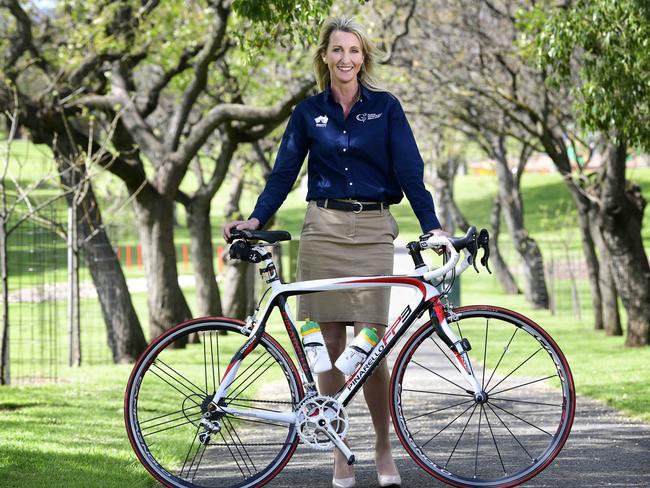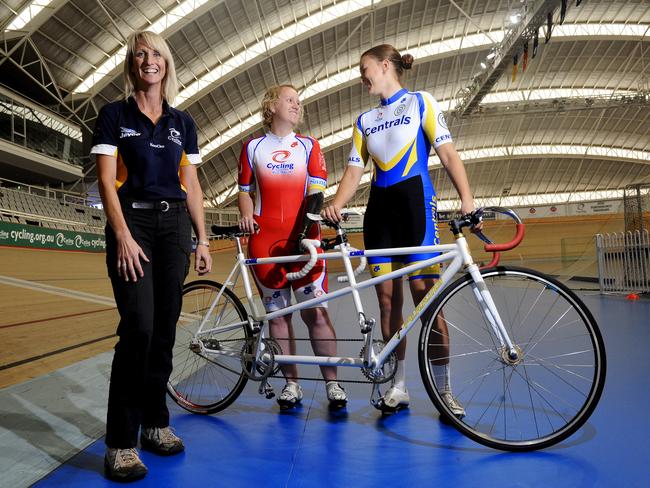Meet Kimberley Conte the woman behind the success of the Santos Women’s TDU
The woman behind the success of the Santos Women’s Tour Down Under, race director Kimberley Conte, shares with Gordon Knight her first cycling love, a secret skill, and that time a hay truck crashed into the finish zone.

Tour Down Under
Don't miss out on the headlines from Tour Down Under. Followed categories will be added to My News.
- The teenager who could topple the TDU favourites
- From hospital ward to TDU, nurse Jess is now a real pro
- The Cuban missile on target for win
- Santos Festival of Cycling offers food, wine, two-wheeled fun
The woman behind the success of the Santos Women’s Tour Down Under, race director Kimberley Conte, shares with Gordon Knight her first cycling love, a secret skill, and that time a hay truck crashed into the finish zone.
Learning to love sport
My grandfather was an avid athlete. At 101, he was still walking 30 miles (50km) a week. He ran until he was 80 and always encouraged me to be active. I grew up in Santa Barbara, California. It’s a great spot to ride a bike, hike and swim.
Freedom to ride
As a girl, I commandeered a beautiful Peugeot race bike that my dad bought for my mum. I was really small as a kid and could barely get on it, but I loved it. I rode that bike for the next 10 years, to school, to work, to the beach. That Peugeot represented freedom.
Climbing to the top
I studied health management and communications. When my kids started getting involved in sport I put my hand up as a volunteer. I first got involved in managing sports other than cycling – soccer in particular, but I also began to coach women cyclists.
Then moving Down Under
I met my husband at a bike race in the US when we were working for a company called Medalist Sports. He was born in Rome, but moved to Australia as a child. We spent a lot of time going between the US and Australia before I moved here.

Redefining disability
Before I moved to Australia I’d been working with kids who have neuromuscular disorders. When a position opened up in paracycling here I’d been coaching cyclists and been involved in pediatric disability. I saw the opportunity to combine those things – putting people who’ve been defined by disability into sport and redefining who they are.

Tour time
The Women’s TDU started five years ago. I was working for Cycling Australia at the time and got the call asking if I’d like to be involved with women’s sport. I’d been involved in the tours of Georgia, California, Missouri, the Colorado Classic and the US Pro Challenge, but the TDU marked the first time I’d stepped up as a race director.
Top-level racing in SA
The first year the Women’s TDU was on the UCI (International Cycling Union) calendar it was an entry-level UCI race. We had a lot of national teams coming across for it, which was fantastic, but I wanted the race to be a better platform for women’s sport. We need an opportunity for riders here, in our own country, to race at the top level. Our riders shouldn’t have to go to Asia or Europe. Now, we have top national teams racing against the best teams in the world.

A year-round job
Being a race director is more than a full-time job, it becomes a lifestyle. Every time I go for a ride I see a stretch of road and add it to my list of “How can I fit that bit into the TDU”. It never stops. Throughout the lead-up I’m dealing with expressions of interest from councils and with the UCI, helping teams get through the immigration process – they require a work visa, and that can be daunting for an athlete whose first language may not be English – discussing traffic management to make sure the roads are safe, meeting the moto pilots (motorcycle outriders) and the commissaires (race judges) and more.

Peloton pressure
When the race arrives I’m dealing with 16 teams (96 riders), team staff, UCI and Cycling Australia officials, trained drivers and moto pilots, 19 SAPOL motorcyclists, photographers. It’s a big circus. And I get all sorts of phone calls at Tour time – “What time is dinner?”, “I’ve forgotten my bike pump”, “Can I store stuff at your house?” During each stage I have to be constantly aware of what’s going on: where every motorbike is, where the tail end of the race is, what might happen in 20 minutes based on what’s currently happening.

Crash!
I always said I wanted more exposure for the Women’s TDU, then, a couple of years ago, a hay truck hit the finish banner and took it down. Video of it went global – which wasn’t really the kind of exposure I wanted. But on the day I instructed my crew to clear the inflatable banner then grab two big flags and hold them either side of the finish line to mark it. In the end that’s all the riders needed.
Tuning out
I’m a classically trained pianist and I still play to relax. While music and cycling demand discipline they both offer freedom of expression.
Originally published as Meet Kimberley Conte the woman behind the success of the Santos Women’s TDU
